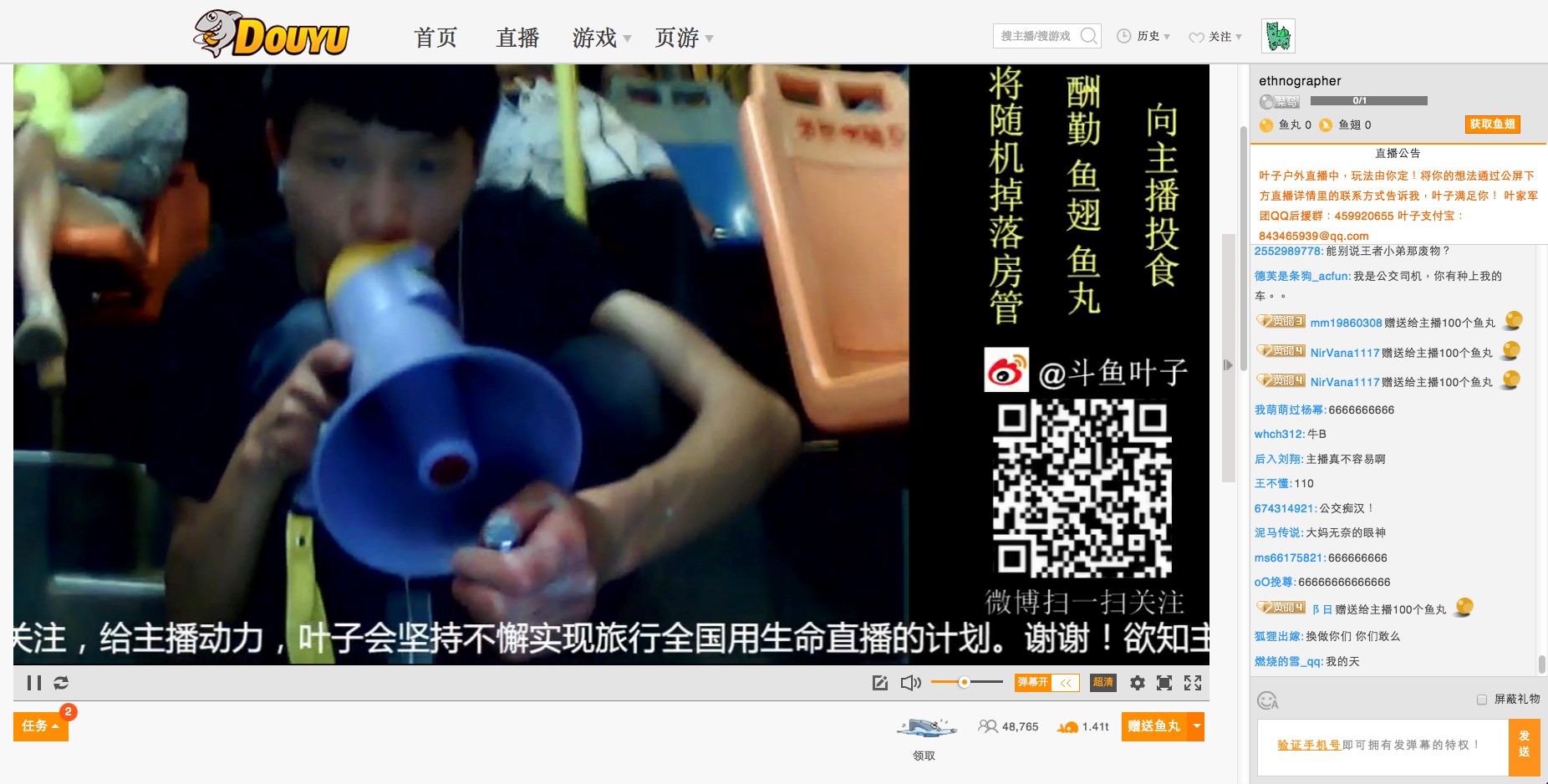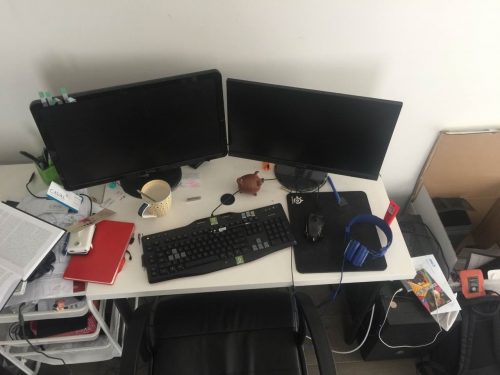 When talking about China, local digital media hypes are often temporalized on a yearly basis, resulting in a peculiar Chinese zodiac of tech-related buzzwords. 2005 was the Year of the Blog, 2008 The Year of Shanzhai, 2009 the Year of Weibo, 2012 the Year of WeChat, 2014 the Year of… well, it’s been the Year of WeChat for a few years now. Anyway, given the disproportionate attention being given to the phenomenon, 2016 is poised to be remembered as the Year of Livestreaming, or, as it is called in Mandarin Chinese, zhibo (literally ‘direct-casting’). The translation is revealing, because while livestreaming is commonly linked to videogaming and event broadcasting on platforms like Twitch (or, more recently, YouTube and Facebook) in Mainland China livestreaming is being adopted as a prominent content format by a wide variety of social media platforms, and has been enthusiastically embraced by users keen to share sights from their everyday lives, often through apps and websites that offer social networking capabilities, live commenting functions and microtransaction-based gifting.
When talking about China, local digital media hypes are often temporalized on a yearly basis, resulting in a peculiar Chinese zodiac of tech-related buzzwords. 2005 was the Year of the Blog, 2008 The Year of Shanzhai, 2009 the Year of Weibo, 2012 the Year of WeChat, 2014 the Year of… well, it’s been the Year of WeChat for a few years now. Anyway, given the disproportionate attention being given to the phenomenon, 2016 is poised to be remembered as the Year of Livestreaming, or, as it is called in Mandarin Chinese, zhibo (literally ‘direct-casting’). The translation is revealing, because while livestreaming is commonly linked to videogaming and event broadcasting on platforms like Twitch (or, more recently, YouTube and Facebook) in Mainland China livestreaming is being adopted as a prominent content format by a wide variety of social media platforms, and has been enthusiastically embraced by users keen to share sights from their everyday lives, often through apps and websites that offer social networking capabilities, live commenting functions and microtransaction-based gifting.
I got in touch with my former colleague Dino Zhang to hear about his ongoing doctoral work at DERC (Digital Ethnography Research Center), and we exchanged a few thoughts around zhibo and content formats on Chinese digital media platforms. In 2014, Dino was kind enough to host me for the brief period in which our fieldworks overlapped in his home city of Wuhan, and we ended up writing some observations about Momo (perhaps 2014 was the Year of Dating Apps, who knows), a social contact app that was much touted as symptomatic of a Chinese “sexual revolution”, but that we instead found to be largely used for combating wuliao (boredom) through group chats and location-based social networking. Quite tellingly, two years later, Momo’s growing profits are fueled by its incorporation of a zhibo function which projects the platform further away from its narrow depiction as a “dating app” and typifies the shapeshifting nature of many local digital media platforms, forced by a competition for hundreds of millions of users to embrace and incorporate the latest functions and content formats.
 Gabriele de Seta: Your previous research project was about internet cafés in a second-tier Chinese city and the changes they went through during large-scale urban restructuring. You’ve also written about social contact apps and explored the concept of boredom in its relation with urban spaces. How did zhibo enter this picture?
Gabriele de Seta: Your previous research project was about internet cafés in a second-tier Chinese city and the changes they went through during large-scale urban restructuring. You’ve also written about social contact apps and explored the concept of boredom in its relation with urban spaces. How did zhibo enter this picture?
Dino Zhang: I have been watching livestreams since 2013. I primarily used Twitch.tv at the time and it was natural for me to begin taking some notes and building an archive of screenshots. Then in 2014 Chinese livestreaming platforms got my attention – Douyu was launched in 2014, followed by many other websites such as Panda TV, mobile platforms like Inke, existing apps relaunched as livestreaming platforms such as Momo, as well as numerous other minor competitors. There are several hundred livestreaming platforms operating in China today; the war for attention is fierce, and the hype is – at least commercially speaking – very real. But I don’t think this is the primary reason why I started doing research on livestreaming. In the past two years, the livestreaming industry in China has grown exponentially in terms of revenue and viewership, and has already mutated multiple times. Just take the example of Douyu: it originally started in 2013 as AcFun Namasho (生放送, livestreaming in Japanese), an integral part of the AcFun video sharing website, which was in itself an imitation of the Japanese platform Niconico. Then Acfun Namasho was relaunched in 2014 as Douyu TV, with a separate domain (douyu.tv) and an independent company behind it. The website was also entirely revamped after the basic style of Twitch.tv while also retaining some of its distinctive core features such as the danmu (bullet barrage) commenting system, and a functional mobile app was also released. To put it simply, Douyu may have initially copied the basic digital infrastructure (web design, protocols, streaming technologies and so forth) of foreign platforms, but the later developments of the service have been primarily determined by the local Chinese context: emerging genres like huwai (outdoor livestreaming), user groups (many zhibo users live in the countryside rather than urban areas), user practices (streaming very mundane activities from ordinary spaces such as workplaces and homes), and aesthetic preferences (what sort of contents are considered fun or comfortable to watch). These peculiarities were what got me interested in Chinese livestreaming platforms in the first place.
 GdS: Has your research on zhibo changed your views about boredom and urban spaces?
GdS: Has your research on zhibo changed your views about boredom and urban spaces?
DZ: My understanding of boredom was closely related to space, urban space to be precise. My previous research identified internet cafés as one example of this spatialized boredom. Despite the many shopping malls and entertainment complexes continuously popping up across Chinese cities, the young urban residents I interviewed evidenced how they still had very few options in terms of leisure spaces. Internet cafés, especially the ones that have been radically renovated in recent years, remain popular destinations, but livestreaming has offered me another perspective on boredom: temporality. Real time broadcasting provides a very comfortable sense of togetherness and security that Chinese audiences used to find in television. I am beginning to realize how, in terms of aesthetics, many Chinese livestreams do not resemble contemporary foreign platforms such as Twitch.tv (which largely focus on the diversity of videogame playthroughs and the competitivity of e-sports) but rather livecam websites from the late 90s and early 2000s such as JenniCam. Yet, while lifecasting remained relatively at the margins of Euro-American livestreaming trends, in China very mundane daily activities have become the main content available on the majority of zhibo platforms. Besides the spectacles of e-sports and the occasional stunts of mainstream celebrities, tens of thousands of people are watching a barbecue vendor, a worker at a construction site, a sleeping girl, guinea pigs on treadmills, a woman eating animal entrails, a limbless person, surveillance camera footage of a building, a person wearing plastic bags walking on the street, and so forth. The mundanity of these zhibo is self-evident, and many of my informants end up asking themselves the same question: why are people watching these boring and meaningless zhibo?
 GdS: A recent article by Hao Wu states that both zhibo hosts and audiences don’t care about politics and that these platforms are merely breeding grounds for “endless banal entertainment”; according to the author, while many microblogging opinion leaders were older generations of better educated urbanites, the userbases of Chinese livestreaming platforms are made of diaosi (‘losers’ [sic]) who waste time and money on them to escape loneliness and hopelessness. In light of your work with streamers and audiences, do you think this characterization is accurate, and that zhibo reflects a further polarization between educated urban residents and uneducated, lonely rural diaosi (however problematic the term is)? Or are things more nuanced?
GdS: A recent article by Hao Wu states that both zhibo hosts and audiences don’t care about politics and that these platforms are merely breeding grounds for “endless banal entertainment”; according to the author, while many microblogging opinion leaders were older generations of better educated urbanites, the userbases of Chinese livestreaming platforms are made of diaosi (‘losers’ [sic]) who waste time and money on them to escape loneliness and hopelessness. In light of your work with streamers and audiences, do you think this characterization is accurate, and that zhibo reflects a further polarization between educated urban residents and uneducated, lonely rural diaosi (however problematic the term is)? Or are things more nuanced?
DZ: That article reflects the popular imagination of zhibo quite accurately— seen from the outside (often through only a few distracted glimpses), zhibo is mostly boring and meaningless, and is regularly disregarded as the lowest tier of Chinese cultural consumption; yet, many people who enter a zhibo channel with this prejudice still get hooked and go back to it regularly. Is it boring? If you look at zhibo generically, of course it seems absurd that anyone would be watching this sort of stuff regularly. But if you start engaging with individual users, the situation becomes way more nuanced. For example, I was talking to a livestreamer called Yuwen who is a disabled young man living in rural Sichuan. His life, according to most standards, is quite tragic. Despite the often abusive comments he receives in chat, Yuwen still carries on streaming because zhibo is an important opportunity for him to speak to a broader audience and receive some money through donations. Yuwen’s zhibo is extremely slow due the long pauses and interruptions resulting from his precarious Internet connection, the resolution of his webcam is very low and even his voice is barely heard over the microphone, yet he speaks in his own capacity and patiently responds to his viewers’ questions. The banality of zhibo contents can be a difficulty because genuine reflexive moments are buried by the duration itself – a six hour-long livestream may contain five minutes of extremely revealing and inspiring conversation about contemporary working life in the Chinese countryside, but only few people would be there to witness, record and publish them. How can we accuse livestreamers of producing “endless banal entertainment” if we have not yet tried to sit there and watch a six hour livestream in its entirety?
 GdS: I guess that this confirms how, like in many other media, genre and affect are central categories that one needs to keep in mind when trying to understand zhibo audiences. In the case of Yuwen, or of many other livestreamers from rural areas or marginal social strata, zhibo seems to be an important resource for finding human contact and sharing the predicaments of one’s everyday life. For others though, especially for the ones who command larger audiences and have turned themselves into livestreaming celebrities across multiple platforms, zhibo becomes a source of income, social capital, and potentially “media power” to use Castell’s term very broadly. Did you encounter examples that can highlight the different kinds of commercial and celebrity streamers?
GdS: I guess that this confirms how, like in many other media, genre and affect are central categories that one needs to keep in mind when trying to understand zhibo audiences. In the case of Yuwen, or of many other livestreamers from rural areas or marginal social strata, zhibo seems to be an important resource for finding human contact and sharing the predicaments of one’s everyday life. For others though, especially for the ones who command larger audiences and have turned themselves into livestreaming celebrities across multiple platforms, zhibo becomes a source of income, social capital, and potentially “media power” to use Castell’s term very broadly. Did you encounter examples that can highlight the different kinds of commercial and celebrity streamers?
DZ: Indeed, zhibo is an attention economy consisting of celebrities who rise and fall all the time. Streamers enjoy different levels of agency according to their individual situation. Some livestreamers have more autonomy while others are strictly controlled by third-party agencies. In terms of revenue, for example, Douyu and Bilibili provide a monthly stipend for livestreamers who are popular enough to be offered a contract with the platform. There are also different ways to generate income depending on what sorts of content you create: If you are predominantly a videogame livestreamer, besides the usual donations and platform stipend, you can obtain some income from external sponsors, and make extra money by selling your own merchandise (usually Taobao snacks) to your viewers. The main difference with platforms like Twitch.tv, however, is how the cash flows. Douyu only allows donations via its own currency system, and strictly bans third-party systems like Alipay or PayPal. Conversely, many camgirls are hired by third-party agencies, so their salary is controlled by the agency rather than Douyu itself. This thriving informal industry is rather complicated and, according to unverifiable informal sources, a large part of Douyu’s revenue could be generated by the backroom deals between the website itself and these third-party agencies.
 GdS: Throughout your answers you emphasized how livestreaming challenges many presuppositions of digital ethnography (it requires synchronous participation rather than asynchronous, it is not automatically archived online, it is largely non-textual, interaction is one-to-many but audiences can respond through text, emojis, stickers, gifts, and so on). Could you outline your methodological approach to livestreaming and its challenges to the ideas of “field”, “participation”, and so on? This could be useful for other researchers getting into the topic.
GdS: Throughout your answers you emphasized how livestreaming challenges many presuppositions of digital ethnography (it requires synchronous participation rather than asynchronous, it is not automatically archived online, it is largely non-textual, interaction is one-to-many but audiences can respond through text, emojis, stickers, gifts, and so on). Could you outline your methodological approach to livestreaming and its challenges to the ideas of “field”, “participation”, and so on? This could be useful for other researchers getting into the topic.
DZ: I am not confident to say that my methods are entirely ethnographic because I improvised so much that I lost track of any central methodological principle. In the past two years, I have regularly watched many genres of zhibo, followed different sorts of streamers (zhubo) and interviewed some of them online and offline, hung out with viewers, attended several fan gatherings, monitored zhibo-related QQ groups, talked to people who do not watch or even hate livestreams, tried streaming myself on different platforms for more than 200 hours, used various software to archive streams and collect chat messages, and so forth. But out of all the things I have done, I think the foundation of my ‘field’ knowledge is built on my sustained efforts of watching zhibo. This daily work of spectating, archiving, and writing notes is the most frequent form of fieldwork I engage in. It sounds very straightforward, and perhaps a bit too casual, since it just involves sitting on in my armchair and viewing livestreams. The difficulty of this kind of research work lies in the endurance required by long-term observation. Every channel or livestreamer has its own particularities which do not necessarily coincide with the general impression you might gather from a cursory viewing of a highlights reel. As a zhibo channel grows, some practices peculiar to it might develop. For example, one livestreamer used to ban whoever donated money to him, and only accepted trolling as proper behavior in his channel – I could figure out the complex patterns of ritualized trolling only through regular observation and participation. Zhibo is very time-sensitive because of its live nature. Without subscribing to a fetishization of liveness, I still believe that the contextual information necessary to understand this sort of medium can be gathered only through long term ethnographic observation (complemented with Internet searches, forum browsing, fan interviewing, and so on). So, being there, watching zhibo and participating in the comment chat while events unfold, is crucial to the understanding of livestreaming.
Gabriele de Seta is a postdoctoral fellow at the Institute of Ethnology, Academia Sinica in Taipei, Taiwan. His research work, grounded on ethnographic engagement across multiple sites, focuses on digital media practices and vernacular creativity in contemporary China. He also experiments with ways of bridging anthropology and art practice. More information are available on his website http://paranom.asia
